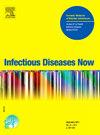Partner treatment strategies for Chlamydia and Gonorrhea: Time for a reappraisal
IF 2.2
4区 医学
Q2 INFECTIOUS DISEASES
引用次数: 0
Abstract
Objectives
Epidemiological treatment for suspected Chlamydia trachomatis (CT) and Neisseria gonorrhoeae (NG) infections is recommended for exposed partners before laboratory confirmation, within 14 days of exposure to reduce symptoms, break transmission chains, and prevent loss of follow-up. This approach may lead to potential antibiotic overuse by uninfected individuals, thereby enhancing antimicrobial resistance. This study investigated the accuracy of epidemiological treatment for CT and NG.
Patients and Methods
Retrospective cross-sectional analysis conducted on asymptomatic exposed partners presumptively treated for CT and/or NG in Lyon’s Sexual Health Clinics between January and December 2023. The positive test rate results of exposed and treated patients were assessed, along with the frequency of potential antibiotic overuse (i.e., receiving at least one unnecessary antibiotic treatment). The association of potential antibiotic overuse with pre-exposure prophylaxis for HIV, age, gender, sexual orientation, and type of contact was also evaluated.
Results
Among 141 patients who received epidemiological treatment, the concordance rate between the test and the reported exposure was 44.8 % for CT and 28.1 % for NG. The proportion of potential antibiotic overuse was 59.6 % (84/141). Potential antibiotic overuse was less common among patients exposed to CT than NG (p = 0.006). Self-identified women (compared with men) and heterosexual (compared with those with other sexual orientations) experienced lower rates of potential antibiotic overuse (p = 0.045 and 0.003, respectively).
Conclusion
Given the good follow-up at our clinics, waiting for the laboratory diagnosis before initiation of treatment appears reasonable and would avoid nearly 60% of unnecessary antibiotic treatments in CT and/or NG asymptomatic exposed partners.
衣原体和淋病的伙伴治疗策略:是时候重新评估了。
目的:建议暴露性伴侣在实验室确诊前,在暴露后14 天内对疑似沙眼衣原体(CT)和淋病奈瑟菌(NG)感染进行流行病学治疗,以减轻症状,切断传播链,防止失去随访。这种方法可能导致未感染个体潜在的抗生素过度使用,从而增强抗菌素耐药性。本研究探讨CT和NG流行病学治疗的准确性。患者和方法:对2023年1月至12月在里昂性健康诊所推定接受CT和/或NG治疗的无症状暴露性伴侣进行回顾性横断面分析。评估暴露和治疗患者的阳性检测率结果,以及潜在的抗生素过度使用频率(即接受至少一种不必要的抗生素治疗)。潜在的抗生素过度使用与HIV暴露前预防、年龄、性别、性取向和接触类型的关系也进行了评估。结果:在接受流行病学治疗的141例患者中,CT检测与报告暴露的符合率为44.8 %,NG为28.1 %。潜在抗生素过度使用比例为59.6 %(84/141)。暴露于CT的患者中潜在的抗生素过度使用比暴露于NG的患者少(p = 0.006)。自我认同的女性(与男性相比)和异性恋者(与其他性取向者相比)潜在的抗生素过度使用率较低(p = 0.045和0.003)。结论:鉴于我们诊所随访良好,等待实验室诊断后开始治疗是合理的,可以避免近60%的CT和/或NG无症状暴露伴侣不必要的抗生素治疗。
本文章由计算机程序翻译,如有差异,请以英文原文为准。
求助全文
约1分钟内获得全文
求助全文
来源期刊

Infectious diseases now
Medicine-Infectious Diseases
CiteScore
7.10
自引率
2.90%
发文量
116
审稿时长
40 days
 求助内容:
求助内容: 应助结果提醒方式:
应助结果提醒方式:


